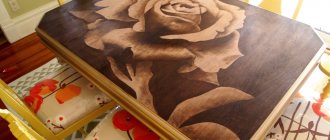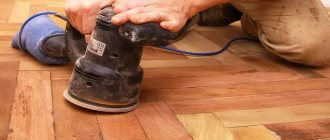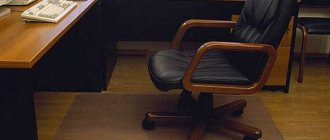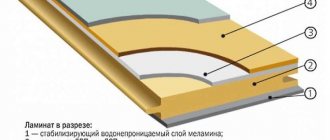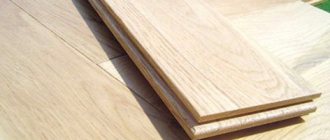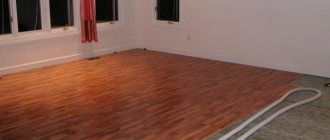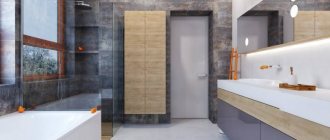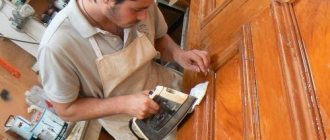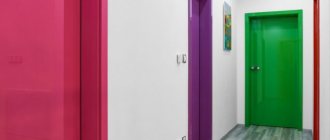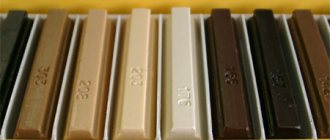One of the biggest problems with natural wood flooring is wear and tear, which can cause the floor to lose its spectacular appearance and require expensive repairs. Significant savings, in this case, will be contributed by painting the parquet, which has several different options. With its help, the floor covering will restore its stylish appearance, plus this will significantly extend its service life.
You don’t have to wait until the surface wears out to change its color; you can do it at any time
Parquet floor painting options
For many people, old and overly worn parquet floors cause a lot of inconvenience. Repairing it, let alone completely changing it, will require quite a large investment, which many of them are not ready for. It is for this reason that owners of apartments with this type of flooring have a question about whether it is possible to paint the parquet and what is needed for this.
Painting a parquet floor is enough to transform the entire interior
You can paint parquet with your own hands using several types of paints and varnishes, with the help of which the floor will regain its presentable appearance, namely:
- parquet paint, specially designed for painting the surface of finishing materials made of natural wood;
- stain, the properties of which allow you to restore the natural texture of the parquet board;
- tinting varnish, which, in addition to coloring, also has protective properties, protecting the parquet from the negative effects of high humidity;
- mastic that has various properties that restore the texture of wood, which can not only give the parquet its original appearance, but also reliably protect its surface.
Each of the above options for restoring the paint layer of a parquet floor covering has certain nuances, to comply with which you must have both certain skills and various specialized tools. That is why the simplest and most affordable option is to paint the floor covering, which will require minimal knowledge and a small amount of tools, often available in any apartment.
As in any other matter, before you start painting, you need to study the base
Modern manufacturers of paints and varnishes supply large quantities of parquet paints to the domestic market, made on a water-soluble acrylic or latex base, due to which these enamels have excellent performance properties and are quite simply applied to a wooden surface. A wide range of colors of water-soluble acrylic and latex enamels allows you to easily match them to any interior design.
Particularly popular is the option of painting parquet flooring white, which many designers recommend using as a neutral element that has an excellent combination with objects of any other shade, and in addition hides minor defects of the parquet board well.
Where to start finishing?
The variety of paint and varnish products on sale allows you to obtain the most unexpected and interesting shades and textures. With the slightest effort and material costs, you can turn an old coating into a true work of art.
So, how to paint parquet flooring yourself? Parquet flooring is painted in 2 stages:
- Applying primer to the wood surface.
- Coating the floor with varnish or paint.
How to properly apply paint to a parquet floor
The big advantage of painting a parquet floor with acrylic or latex enamel is that the entire process can be done with your own hands, without the need to involve third-party specialists, which will make it possible to significantly save on floor repairs.
For these purposes, it is worth purchasing the necessary paint, putty, a special primer for wooden surfaces, sealant, an electric sander with a set of sandpaper and several brushes with rollers, after which you can safely start painting, strictly following all the steps listed below:
Tools and consumables for painting are not that expensive and will definitely come in handy around the house
At the first stage, the so-called sanding is carried out, which is a thorough removal of all paint and varnish materials that were previously applied to the old parquet. This is done using a grinding machine, onto which coarse-grain sandpaper is mounted. As the floor is treated, it is gradually changed to fine-grained. Before sanding, it would be useful to place a protective film on the walls, in the lower part, which will protect their decorative finish from accidental damage.
After sanding, it is necessary to carefully inspect all parquet boards for their deformation and the presence of mechanical damage, which can significantly spoil the appearance after painting the floor. Any minor damage found is treated with putty and re-sanded, and heavily damaged boards of the old parquet are replaced with new ones.
Drum type machine for parquet scraping
At the third stage, all the seams of the parquet boards are treated with sealant to protect against moisture getting inside, after which the room is completely cleaned, removing all dirt and grease marks on the floor. Next, apply a layer of primer to the floor covering and leave for a couple of hours until completely dry. The primer is needed in order to fill all the pores in the parquet boards and for more effective adhesion of the paint to the surface of the floor covering, as a result of which the service life of the parquet board is significantly increased.
How to restore old parquet without sanding
Without sanding, parquet can be restored using cosmetic putty, parquet glue and specialized equipment. Most cracks and dents can be removed with proper putty. Loose or unsuitable areas can be replaced, and then these places can be puttied and varnished.
How to renew parquet flooring with cosmetic putty with your own hands: joints, dents, cracks
For minor damage, such as material falling out of the seams, cosmetic putty is used. It will help eliminate cracks no more than 5 mm. and will hide small dents.
To apply the putty, it is recommended to use a rubber or metal spatula. Excess around the seam is immediately removed with a sponge, and if the putty is epoxy-based, it is recommended to use a stencil to avoid getting it on the dies.
If such material gets on the boards, it can be removed with a solvent. After hardening, it is necessary to sand, remove dust and varnish.
How to choose putty
When choosing putty for parquet, you need to pay attention to its purpose. That is, it must be indicated that it is suitable for parquet and plank floors.
The second thing you should pay attention to is the color; it should not be too dark or light relative to the overall color.
Formation of joints
If during the puttying process the joints are filled flush with the entire surface and the pattern is broken, then the seams must be renewed.
The formation of joints must be carried out when the putty sets.
A ruler is applied to the joint and a line is drawn under it with an awl. When the putty has completely hardened, this process will require effort to scratch the seam.
Repairing a wide gap between parquet flooring
Hook for parquet boards
Putty is not suitable for repairing cracks larger than 5 mm. When laying dies in parallel, they heat up for 15-20 minutes, and then they are moved with a tie hook so that 2 narrow gaps are formed, which can be eliminated with putty.
If a gap has formed between several boards, they are moved to one side using the same tool. A narrow strip is placed in the resulting void, flush with the entire parquet. When laying patterned parquet, the voids are filled with thin wood chips mixed with putty.
Removing damage to parquet using wax
Fastening loose parquet floors
Parquet flooring can become loose over time for various reasons and this needs to be corrected before painting. There are 3 ways to secure loose elements.
Fastening with nails
Nails can help out when fixing problems with loose parquet boards. Nails 15-20 mm long are driven into the gap between the parquet flooring at an angle of 45 degrees.
It is important to know that after driving a nail with a hammer, its head must be deepened into the wood with a hammer.
Afterwards these places are plastered and sanded. In this way, fixation of loose parts is achieved.
Fastening to the base with glue through the holes
Some of the dies could rise up and lag a little from the floor, but they are no longer damaged in any way. In this case, there is no need to remove them. It is enough to make several holes in each loose part.
After this, you need to inject glue into them using a mounting gun or syringe. At the end, add sawdust left over from drilling to hide the holes.
It is recommended to use a two-component one; its drying time is about a day. When the glue is introduced, you need to leave the boards under pressure until completely dry.
Fastening parquet flooring with bamboo
This original method works due to the unique properties of bamboo. This material is highly hygroscopic (it absorbs moisture from the air), so it will quickly swell and prevent the slats from moving.
In order to make this type of fastening, it is necessary to drill 2 holes at the joints of parquet elements with a diameter of 5-6 mm. Bamboo chops are driven into them, which are trimmed if necessary.
The parquet creaks in some areas
Parquet squeaking can have several reasons. These include:
- wobbly dies,
- voids under the parquet,
- sagging of spacer wedges.
Each cause is corrected differently. So if the problem is with the dies, then everything can be solved by fixing them or replacing them.
If there are voids under the parquet, there are several ways to solve the problem. The easiest way is to drill several holes in each problem part and pour glue through them until the voids are completely filled. Afterwards, a press is installed on top of the hammered pins.
You can also use crushed wax to eliminate voids. It must be carefully poured into the joints between the boards, pushing it into the cracks with a spatula and a brush. As soon as the void is filled, the creaking part of the parquet is heated with a hairdryer.
If the cause of the squeak is the spacer wedges, then they need to be replaced. This procedure can only be done when humidity is less than 40%. In these simple ways you can remove creaking parquet flooring.
Coating swelling
Parquet may swell if over-moistened. If this happens, you need to act as soon as possible; a successful outcome depends on when the repairs are made.
To eliminate this problem, the swollen coating must be heated with a hairdryer until the smell of mastic and heated varnish appears. All the moisture will not go away, but the wood will become more pliable.
After heating, we place plywood 8-10 mm thick on this area and leave it under pressure for a day. If after these manipulations the swelling remains, you can repeat the procedure 3-4 times.
If the swelling is successfully corrected, it is necessary to dismantle the old putty and re-putty the seams. After puttying, it is important to leave this area under a load until it dries completely, otherwise the swelling may return.
Swelling of parquet can only be corrected while the board is wet; otherwise, the damaged area will need to be replaced.
What to do if the dies have come off - reinstall part of the parquet
Removing stuck gum
There are several ways to remove chewing gum from parquet floors.
- Using a wooden spatula, gradually lift up the newly glued gum.
- Heat the contamination and carefully remove the soft chewing gum.
- Let it cool and it will become hard and come off easily.
When to paint parquet
Although hardwood floors last a long time, they do not last forever. A clear sign that it is time to renew the flooring will be wear and tear on the flooring. If it has worn down, nicks have formed on the boards, and the varnish has worn off, then repairs are necessary. Not everyone knows whether the parquet can be painted or whether it will have to be completely replaced. In fact, there is nothing complicated about it. You can carry out all the repair work yourself, and it will cost less than completely replacing the materials with new ones. A painted board will look renewed and will last for several more years or decades.
Selection of materials for painting
To restore the coating, you can use the classical method. A layer of stain is applied to the base to highlight the wood structure, and then varnish is used. However, this method is not suitable for cases where the boards are very worn. In this situation, you will need to use a coating coating. When restoring the floor, water-soluble paints are used. Parquet is painted using acrylic or latex enamels. They have a high wear resistance threshold. To select the material, follow the following recommendations:
- Please ensure that the paint is intended specifically for floors. The boards will be constantly exposed to stress, so the material must withstand them.
- Is it possible to paint parquet floors with a different color paint? It is possible, but not recommended. It is best to choose a shade 1 - 2 shades darker than the previous one. You should not experiment with colors that are too light (especially white), as they will be difficult to apply.
- If the parquet pattern is beautiful and you want to preserve it, you need to choose a material that does not affect the structure of the boards. Most often, this is not a very dense paint, which only refreshes the shade.
- Pay attention to the absorbency of the wood and the type of parquet board. For example, painting pine should be done only with paints that are designed for soft wood. Classic materials are suitable for oak coverings.
Water-soluble acrylic enamels
Acrylic enamel is a fairly popular paint for parquet. She has an impressive list of positive qualities. We are talking about an affordable price, resistance to temperature changes, as well as safety during application. The paint dries quickly and there is no specific odor during work. In addition, acrylic enamel allows wood to “breathe” because it has good permeability. The renewed coating will last 5 – 10 years. In most cases, semi-gloss enamel is purchased for floors. When it dries, it forms an elastic film with high strength on the surface.
Latex enamels
This is one of the types of water-soluble materials. Latex enamel has the same advantages as acrylic enamel. The only difference is the service life of the coating. If you use this paint, you can forget about repairs for the next 15 to 20 years. After application, surface care will become easier. It will be easier to clean the floors from dirt, since a dense glossy film will form. Another plus is that latex enamel is applied in a thin layer and does not affect the structure of the boards. The drawing remains the same. The only possible disadvantage is insufficient resistance to sub-zero temperatures.
Painting parquet, useful tips
Replacing parquet with a new one is quite an expensive and time-consuming undertaking.
Therefore, during renovations, people often ask the question: is it possible to paint parquet floors themselves? There is an answer to the question, and it is positive.
Staining will not only give new life to your parquet floor, but will make it much more attractive. If desired, it is possible to use colored coloring compounds or stain.
But before you arm yourself with brushes and a roller, it doesn’t hurt to familiarize yourself with the technology of painting the floor. We will tell you about it in this article.
Where to start finishing?
The variety of paint and varnish products on sale allows you to obtain the most unexpected and interesting shades and textures. With the slightest effort and material costs, you can turn an old coating into a true work of art.
So, how to paint parquet flooring yourself? Parquet flooring is painted in 2 stages:
- Applying primer to the wood surface.
- Coating the floor with varnish or paint.
Selection of paints and varnishes
When choosing paint, you need to consider brands designed specifically for the floor, taking into account the increased load that parquet experiences.
As for the shade, you need to choose the option that is in harmony with the interior.
However, in order for the result to be truly impressive, you need to take a color that is about one tone darker than the original one.
Important! Is it possible to paint parquet boards a different color? There is nothing stopping you from painting the floor a light color, even white, but any imperfections on such a surface will be much more noticeable.
Decide whether you want to radically change the color of the floor or just refresh the coating:
- The natural texture of wood is hardly worth hiding under paint. There are also paints on sale that preserve the natural texture and beauty of wood.
- It is also necessary to take into account the type of wood from which the parquet is made. For example, for a pine board, a varnish intended for soft wood is suitable. But, since the most common one is oak parquet, most of the standard varnishes and dyes are designed specifically for oak.
Let's look at the most common types of paints.
Acrylic water soluble
These paints are popular for plank flooring. Distinctive features of acrylic paints:
- Low cost.
- Variety of color options.
- Resistant to temperature changes.
- Safety.
- No unpleasant odors during operation.
- “Breathing” properties (vapour permeability).
- Fast drying.
Important! The service life of such flooring is 4-10 years. Semi-gloss enamels are best suited for painting floor coverings.
Latex compounds
Another option for painting parquet is latex solutions. The basis for obtaining latex paint is the juice of rubber plants. Latex-type paints have the same advantages as acrylic paints.
Caring for floors painted with latex paint is very simple. It can be kept clean with absolutely no effort.
Important! The advantage of latex dye is a thin layer of application. This means that the wood texture can be preserved.
Latex also has its disadvantages. In particular, it does not tolerate low temperatures well.
However, for home flooring this is not critical.
Primer
When varnishing a parquet floor, preliminary coating with a primer is mandatory.
Important! The primer allows you to eliminate small defects (chips and cracks), as well as apply the varnish in a more even layer. Wood treated with a primer is unattractive to bacteria and mold.
You need to choose a primer depending on the type of varnish used:
- For solvent-based or polyurethane varnish, a similar primer composition is suitable.
- Acrylic type primer is suitable for water-dispersion varnish.
Important! If you don't want the board to change color, use a clear product.
Preparing the floor for work
Painting parquet flooring is a slightly more labor-intensive task than painting a regular plank floor. Preparatory work is advisable for a new parquet floor, but for an old flooring it is completely mandatory.
The floor is prepared according to the following algorithm:
- Clean the floor from dirt: sweep and then wash.
- Using film, protect the walls at the bottom if they have a decorative coating.
- Inspect the parquet. Delaminated or sagging boards need to be replaced.
Before painting old parquet, you need to remove any remnants of old varnish, primer or paint from it so that only clean wood remains. This process is called scraping.
Important! It is advisable to sand the floor using a special sanding machine.
Companies that renovate apartments provide this service, and the prices are quite reasonable.
If you want to do everything yourself, there is no need to buy expensive equipment. The same repair companies rent out equipment.
When sanding the floor, you must wear a respirator and safety glasses. Take care to ventilate the room. It is advisable that the grinding device be equipped with a dust collector. When grinding, different attachments are used:
- Primary processing of the coating is carried out with coarse sandpaper in a diagonal direction. The next track overlaps the previous one by about 50 mm.
- The second stage is the use of a nozzle with medium-grain sandpaper. It is carried out diagonally, in a direction perpendicular to the primary one.
- The last stage is the use of fine-grained sandpaper for processing.
- The most difficult to access areas are sanded by hand.
Preparing for work
Before you begin restoring old parquet, you need to properly prepare it for work. To do this, follow the following sequence of actions:
- First, remove the remnants of the previous coating. This can be varnish, paint or primer. You need to get to the wood itself. It is most convenient to use a grinding machine for this. You can do this manually, although it will take much more time and effort. Before carrying out work, it is necessary to protect your eyes and ears from dust entering them. Also, take care of a respirator in advance to protect your respiratory system.
- When sanding, use different attachments alternately. First, use sandpaper with a rough texture. It is used to clean the surface diagonally. The overlap with the subsequent path should be 5 cm. Then use a medium-grained nozzle. They also move diagonally, but in the opposite direction. The last step is to sand the floors with fine-grained sandpaper.
- Check to see how well the floors are cleaned. If a sanding machine is used, the parquet must be sanded manually in the corners.
- After sanding is completed, the room must be thoroughly cleaned of dust. The surface is vacuumed and checked for obvious chips or cracks. It is best to replace boards with severe defects before painting.
What is scraping and how can it be carried out?
Sanding is a technology for leveling wood surfaces by scraping (removing a thin layer of chips). This process can be carried out using a scraping machine, an electric planer, or a hand scraper. After this procedure, the damaged floor will look like new.
cycle
A manual scraper is a metal scraper with a wooden handle. It perfectly removes paint or varnish layers. A medium-sharp metal plate is inserted inside the tool, which helps remove wood chips without damaging the structure of the dies.
If you have the opportunity to rent a sanding machine, take advantage of it. This will save you time and effort.
Sanding with feet
When sanding parquet, it is recommended to sand it with your feet rather than your hands. This way the pressing force is higher and less effort is wasted. To do this, you need to glue sandpaper to the sole and rub the floor.
a scraper made from improvised tools
Applying paint
After completing the preparatory stage, you can paint the old parquet with a pre-selected enamel. To do this you will need to choose the right tools. You can use a regular brush. However, this will take a lot of time. Therefore, it is most often recommended to buy a roller or sprayer. You should not use products made from foam rubber, as they leave marks and do not paint uneven surfaces very well. Even after drying, it will be noticeable that the paint applied unevenly. To paint the floor, it is better to purchase a roller made of wool or mohair (with a long handle). If liquid paint is used for repair work, a special sprayer can be used. In addition, it is suitable for those cases when you need to process a large area, and doing it manually is difficult. Before painting the parquet, you must once again make sure that there is no dust or other visible contaminants left on the boards. The further process consists of the following steps:
- Make sure there is access to fresh air in the room. Vapors most often have a negative effect on the human body.
- To avoid damaging your clothes, use a special suit. Also wear a respirator to protect your respiratory tract.
- The composition must be applied from the far corner of the room, gradually moving towards the exit.
- Make sure that the paint does not pool and form uneven spots. Wipe them immediately with a dry cloth and reapply the enamel, as it dries quickly. For the same reason, you need to immediately erase marks if you accidentally hit walls or any objects.
- If additional varnish is applied, the floor will need to be covered in several layers. Each subsequent one is placed across the previous one. At least 2 days should pass between application of layers.
Water-soluble enamels dry on average 10 – 12 hours. It is necessary to wait this period before starting to apply a new layer (if more than one layer will be applied). To ensure that no traces remain on the painted floor, it is recommended to install furniture no earlier than 1 - 2 weeks after the repair. But you can walk on the boards the next day.
How to paint parquet - simple instructions for beginners. Photos of finished options
As everyone knows, over the years everything wears out, wallpaper loses its color, furniture upholstery becomes deformed, parquet gets worn down and worn down. If all this happened in your home, then it’s time for repairs.
Owners of parquet floors are most often interested in whether it is possible to simply improve the condition of the flooring without changing it. After all, completely replacing parquet flooring is time-consuming and expensive.
There is an easy way to update the appearance of worn flooring, and it is available to everyone, just paint the old parquet flooring.
Painted parquet gets a second chance at life; it will look refreshed and not trampled. But before you start painting, familiarize yourself with the material.
Selection of materials for painting
Preparing for painting is a very interesting and entertaining process. In recent years, the market for paints and varnishes has expanded greatly. Paint can transform your floor into a work of art.
But so that the painting does not become a failure, and you do not have to replace the wooden covering, you need to buy a good varnish. That’s right, the chosen material will give the parquet a new look and a chance for long-term use.
It is necessary to choose a paint made for wood coatings.
It’s easy to find these materials; in every hardware store and on the market there is a huge selection of such paints.
The question is often asked whether it is possible to paint parquet floors with regular paint, the answer is simple, it is possible, but for how long.
Paint intended for parquet is more resistant, as it is prepared for heavy loads and daily use.
First, choose a paint color; it should be darker than the previous one.
Then you need to decide whether you want to change the color of the flooring or simply refresh it.
As a rule, painting floors begins with applying a primer to the wood, after which enamel or varnish is applied to the boards.
Let's consider the types of materials needed
Primer. With the help of this material, parquet defects are removed, and the application of varnish becomes easier. A well-applied primer will improve the condition of the wood and extend its service life.
Choose a primer based on the varnish and paint; the base should be the same. To avoid changing the color of the coating, use a primer with a colorless composition.
Acrylic water-soluble enamel. This type of paint is the most common for wood coating. This enamel has advantageous qualities such as:
1. Reasonable price.
2. Large range of colors.
3. Odorless.
4. Tolerates any temperature regime.
5. Instant drying.
6. Service life 5-8 years.
Preparing the coating for painting
Before you start priming and painting the parquet, you need to clean it of old primer, varnish and paint, so well that clean wood remains.
A sanding machine can handle this step well. If you don't have one, you can rent one or hire a professional sander.
Before cleaning the floor you must:
1. Check the parquet boards for broken ones; they will have to be replaced.
2. Sweep and wash the floor.
3. Cover the walls with film 30-40cm from the floor.
Sanding the old coating takes place in three stages:
- The entire parquet is processed with coarse sandpaper, moving diagonally across the room.
- Vertically with the previous diagonal using a medium-grain nozzle.
- In the corners of the room, if necessary, you will have to sand it manually with fine-grained sandpaper.
The coating is considered cleaned only when the color of the parquet has changed and pure wood is visible.
Parquet painting
Before painting, make sure you choose the right tool for the job.
This should be a roller made of wool or terry, and under no circumstances a foam roller. In addition, you can use a paint brush or sprayer.
Step-by-step guide on how to paint parquet flooring:
1. Check the cleanliness of the floor.
2. Open the windows for ventilation.
3. Wear old things (which is not a shame).
4. Apply varnish from window to door.
5. Stock up on a dry cloth to remove paint drops from the still painted floor.
6. Coat the wood with two or more layers of varnish. The interval between layers is two days.
It is advisable to fill the room with furniture, lay a carpet and use the painted parquet in full no earlier than two weeks after painting.
Photo ideas on how to paint parquet with your own hands
Wallpaper for the kitchen - 120 photos of the best solutions for wallpaper design in the kitchen
Source: https://mirdizajna.ru/kak-pokrasit-parket/
Application of varnishes for parquet coating
The most common transparent or tinted composition for treating wood and preserving its original natural appearance is varnish. It creates a protective film on the wood that prevents the parquet board from absorbing moisture, and also protects the floor from scratches, chips, splinters and deformation due to temperature changes.
There are water-based and acrylic-based parquet varnishes, alkyd varnishes, and quick-drying nitro varnishes. Each type has undeniable advantages and disadvantages. The advantages of parquet varnishes include:
- No wood painting. The parquet retains its natural color;
- Resistance to moisture and changes in ambient temperature;
- A protective layer that preserves the board from external influences;
- Aesthetically attractive appearance;
- Low cost.
But varnish for parquet boards also has some disadvantages. This:
- Long drying time of the composition. Nitrovarnishes emit harmful fumes, although they dry quickly;
- Cracks that appear over time on the varnish surface are very noticeable;
- To re-process, it is necessary to completely remove the previous layer and re-process the wood;
- Requires special equipment for application;
- Most often not resistant to alcohol.
Nevertheless, varnishing parquet boards does not go out of fashion and is one of the most reliable ways to protect floors. And visually, the varnished board looks attractive. High-quality modern varnishes allow you to avoid most of the shortcomings.
Parquet oil
An environmentally friendly method of treating floors, which appeared on the market of paints and varnishes relatively recently, is oil compositions. Unlike varnishes, it impregnates and protects the wood more deeply, and it dries in the shortest possible time. The absence of harmful fumes during use also plays an important role in choosing this coating method for a home where there are children or people with allergies.
The oil is applied in one layer, which does not require additional equipment or any special skills. Does not crack over time and is resistant to alcohol. But, of course, like any composition, the oil also has its disadvantages:
- Oil coating does not protect the parquet board from sudden temperature changes;
- Changes the shade of wood, makes it darker, although it emphasizes the structure;
- Does not create an additional layer that protects the parquet from scratches and impacts, and your feet from splinters;
- It has a higher cost than varnish compositions.
Despite the presence of negative characteristics, oil compositions are perfect for those who need environmentally friendly and safe floors, as well as ease of application and processing.
The essence and general principles of tinting
During tinting, the wood is painted in one color or another, while its natural texture is completely preserved. The color may be specific to a given type of wood, and a thicker shade may be chosen to highlight the lines of the wood layers. They also use tinting to match more expensive types. A common technique is to use dark tones to create the visual impression of old wood that has darkened over the years. Tinting should be considered in the context of the overall design idea, being its important means of expression, complementing the overall picture.
Toning has a number of advantages over other finishing methods:
- applicable to any wooden surfaces;
- helps hide small wood defects;
- refreshes the boards of old, worn parquet, the impression of the room as a whole;
- does not require large expenditures of money or time;
- many colors available.
Toning does not protect wood from wear and stains. After this, it is necessary to apply a protective layer of varnish or impregnate with oil.
Antiseptic compounds and impregnations for high-quality parquet processing
In fact, a parquet board is ordinary wood, only of high quality with improved characteristics, because the floor has to withstand maximum load. Therefore, processing parquet is not much different from processing wooden panels and products.
The floors should first be prepared for painting by removing all previous layers of varnish and paint, and even the top layer of wood. Then the parquet is well impregnated with protective antiseptic and water-repellent agents, after which the floor is painted with the selected type and color of paint.
The choice of antiseptics is important. A correctly selected composition will qualitatively and permanently protect the floor covering from the destructive effects of moisture, ultraviolet radiation and various bacteria. Antiseptic compounds are applied to cleaned and sanded wood, after which the boards can be coated with varnishes, paints or oil compounds.
Impregnations provide additional protection and improve the appearance of parquet boards. The composition can be used to treat pre-painted coatings, facilitating subsequent floor care and increasing the wear resistance of paints and wood. Thanks to impregnation, you can restore old parquet flooring to its excellent appearance and update the interior of the room.
How to prepare a board for painting
Preparation for painting takes place in several stages, namely:
- preliminary cleaning of the floor from dirt, grease and dust;
- removal of previous paintwork;
- sealing and puttying cracks and small irregularities;
- grinding and sanding the surface;
- application of antiseptic agents;
- impregnation with drying oil, priming.
Features of the preparatory work may vary depending on the type of flooring, type of wood, as well as the conditions of further use. A careful approach to the preparatory process guarantees the effectiveness of further painting of the floorboards.
Regardless of which painting method you decide to prefer, preparation for painting should take into account the strength characteristics of the material and its tendency to deform. The processing and pre-cleaning procedure is accompanied by mechanical stress on the coating.
Parquet processing
Depending on what composition the parquet board will be treated with, the necessary properties of pre-treatment, as well as subsequent care of the floors, change.
When treating parquet with varnish compounds, you must ensure that there is no dust, dirt or moisture on the wood. First, the top layer is removed from the board, after which it is primed and varnished in several layers. Varnish compositions can be matte, glossy, with additional shades and are applied using special equipment in several layers. This coating lasts for years, is easy to clean and looks beautiful.
Oil or oil-wax compositions for parquet are applied to pre-cleaned and treated lamellas. Unlike varnish, they do not require repeated processing - often two layers are enough, which can be applied independently without additional equipment. If you do not impregnate the oil coating with additional impregnations, the surface of the parquet board will be glossy, creating the effect of untreated wood. It is more difficult to care for such a floor, since cleaning will require additional detergents.
The main mistakes in tinting parquet boards
- After applying the composition, the floor is covered with rings and strips . The defect is caused by poor-quality floor sanding. Longitudinal darkened lines are the result of the influence of a belt machine, concentric ones are errors in working with surface grinding equipment, circles along the walls indicate rough processing of an angle grinder.
- The appearance of stains after tinting is due to uneven absorption of the coloring composition by the wood. Beech can react very unpredictably to staining due to its hygroscopicity.
- The formation of overlaps and joints on parquet is the result of unprofessional color distribution on the floor surface.
Important! Pine is a rather difficult wood to process due to the softness of its structure. Minor failures during sanding will lead to the appearance of “stains” and stripes on the parquet. The probability of defects when sanding larch and oak is much less.
Choosing the final coating for parquet
To make the final choice of the composition that should be used to treat a wooden floor, it is worth considering several factors.
Residential or public premises
For a small room with a small visitor, covering parquet boards with oil compounds is quite suitable. This flooring will create a special atmosphere of comfort in the room with its naturalness and pleasant appearance.
For public places it is better to use varnish treatment. Such a floor will be easier to clean and the varnish coating will provide more reliable protection for the wood.
High or low ambient humidity
Rooms with high moisture should be treated with oil. In such conditions, the varnish coating can quickly crack due to deformation of the board, losing its useful properties and appearance.
Necessary environmental safety for residents
In rooms where small children live, who like to sit and crawl on the floor, oil coating has advantages over varnish compositions. But it is worth remembering that when choosing any composition for flooring, you should pay attention to the presence of the necessary certification and confirmation of the safety of the coating.
Permanent or temporary coverage
Considering that oil saturates the parquet board quite deeply, it will be almost impossible to switch from oil to varnish. Applying varnish compounds to a previously oiled board can lead to cracking of the slats and damage to the entire floor.
Coverage cost
The price depends on various factors - manufacturer, components, quality, functionality of the composition. On average, a varnish coating is cheaper, although if you purchase oil-based coatings with enhanced protective functions, it can cost more.
Based on these facts, you can decide what is better for a parquet board - varnish or oil, only for your own case. There is no general clear answer. The main thing is that the coating is made from high-quality, proven compounds and meets all aesthetic expectations.
How to cover concrete floors and why it can be useful
Concrete is widely used in construction. This material is suitable not only for creating foundations and walls, but also for producing floors. Concrete is used in residential, warehouse, industrial and technical premises.
(2, 13722346, 100181)
Concrete paints are available for interior or exterior decoration
If the technology is followed, the base will be strong and durable. But this material is not without its shortcomings. Without a protective layer, its surface is subject to abrasion, which is also destructive to negative causes. Therefore, the question inevitably arises about how to paint concrete in order to extend its service life. When choosing a protective composition, you should first take into account the operating conditions.
Depending on the criteria under which the treated surface will be used, paints are divided into:
- For coatings for interior work and compositions for exterior finishing.
Any group of dyes has its own characteristics and properties that allow the use of these materials under certain conditions.
Specifics of paints for concrete floors in garages
A concrete base is one of the most reliable and cheapest coating options, which is why screed is often used to create garage floors. But do not forget that such a surface is constantly exposed to mechanical overloads, as well as to the action of brutal substances. In addition, during use, cement dust accumulates on it.
(3, 51305931, 100181)
Alkyd, oil and organofluorine compounds are not suitable for painting a garage.
The right paint will help you cope with similar problems. Since it will be used indoors, special requirements are imposed on such coatings. The paint for garage floors must be:
- Wear-resistant, odorless, fire-resistant, chemical-resistant, quick-drying, washable, weather-resistant.
Unfortunately, there is no universally suitable composition that would 100% meet all of the listed requirements. Therefore, the paint is selected based on the operational criteria of the room.
(4, 39921149, 100181)
Garage paint must be washable, fire-resistant, wear-resistant
How to paint concrete floors outdoors: compositions for external work
Typically, concrete is used in open areas, so some users do not see the need to use floor paints for external work. They believe that, having the highest strength and beautiful technical features, this material does not require additional protection and can be successfully used in virtually all conditions. In fact, this is not true. Concrete pavement exposed to the open air is subject to the destructive effects of the following negative reasons:
- Precipitation and wind, low and high temperatures, as well as changes in ultraviolet radiation from industrial gases.
Concrete screed has a high degree of porosity, so the material perfectly absorbs water, which can fall on its surface in the form of precipitation or spilled liquids, or simply come from the atmosphere. Without a high-quality protective coating, all this will remain and accumulate inside the base, which is extremely critical for its condition. Especially in this case, if dirt or petroleum products, for example, antifreeze, gasoline or oil, have got on the surface.
Concrete surfaces in the open air are subject to shock overloads, friction and abrasives. In such conditions, access areas, parking areas created for trucks, and overpasses are used. Without adequate protection, the screed will quickly lose its attractive appearance and become unsuitable for use. The concrete will show chips, cracks, tears and potholes. Therefore, it is extremely important to select a suitable composition to protect the surface.
(5, 51878369, 100181)
For external work, special varnishes for concrete, impregnation and polymer enamel are suitable
How to paint concrete outside? For this purpose, the following types of coatings are used:
Impregnation - the product penetrates through the pores into the thickness of the material by 7-10 mm and hardens, preventing dirt and water from getting inside. After treatment, the concrete surface becomes stronger. Such a base can withstand moderate overloads. The disadvantages of impregnations include only a limited service life. Polymer enamel is considered a good protection option. This category of coatings includes compositions containing epoxy resins, acrylic or polyurethane. Special varnish for concrete floors - made on a water dispersion base and includes latex components. The product is used for insulating concrete screeds.
